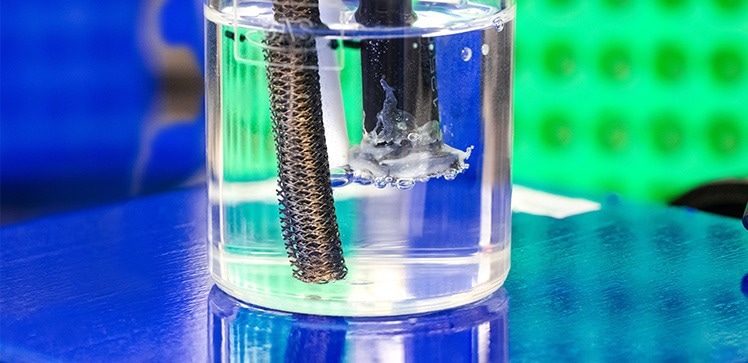A biological approach that creates metal nanoclusters with the electroactive bacterium Geobacter sulfurreducens could offer an economical and sustainable solution to high-performance catalyst synthesis for a wide range of applications.

Using bacteria to produce metal nanoclusters could be a greener and more efficient way to produce precious catalysts used in industry. Image Credit: © 2023 KAUST; Anastasia Serin.
Fewer than 100 atoms are present in the metal nanoclusters. They are much tinier than nanoparticles and exhibit unique electronic properties, but they also have several active sites available for catalysis on their surface. For producing metal nanoclusters, there are numerous synthetic methods available, but a majority of them need multiple steps involving toxic substances, pressure conditions, and harsh temperatures.
Biological approaches are anticipated to supply environmental-friendly substitutes to traditional chemical synthesis. Up to now, they have only resulted in large nanoparticles in extensive size ranges.
“We found a way to control the size of the nanoclusters,” states Rodrigo Jimenez-Sandoval, a Ph.D. candidate in Pascal Saikaly’s group at KAUST.
The research team analyzed the creation of biohybrid materials with the already existing knowledge that the surface of electroactive bacterial cells can act as a support for single metal atoms. These biohybrid materials comprised palladium nanoclusters affixed to the bacterial surface of G. sulfurreducens cells.
This bacterium is readily available in the soil and can transfer electrons to metals that are present outside the cell and also conduct electricity if grown on an electrode of a microbial electrochemical system. It served as a reducing agent and a conductive scaffold for the nanoclusters in this study.
Drawing from nanoparticle chemical synthesis, the scientists agreed to regulate the metal precursor concentration in their arrangement. Jimenez-Sandoval states, “To come up with this idea, we had to think of G. sulfurreducens as a chemical entity instead of a biological entity.”
They found that adding the metal precursor step by step was the basis for fine-tuning nanocluster size and distribution and, finally, catalytic performance.
As a proof of concept, the scientists tested the catalytic performance of the as-synthesized nanoclusters affixed to the bacterial surface for the complete water-splitting reaction, involving breaking down water into gaseous hydrogen and oxygen electrochemically.
In alkaline solutions, the nanoclusters outdid standard iridium- and platinum-based catalysts that are employed for the oxygen and hydrogen evolution reactions.
“These results have very important implications in real life applications because a catalyst synthesized with a biological method is not only cheaper and simpler but also greener,” Jimenez-Sandoval concludes.
Currently, the team is working to create a biohybrid catalyst that does not depend on noble metals but a more economical and abundant material to improve the sustainability of their strategy.
Bacterial route to cleaner catalysis
Learn how KAUST scientists are developing more sustainable catalysts from bacteria. Video Credit: © 2023 KAUST; Anastasia Serin.
Journal Reference
Jimenez-Sandoval, R., et al. (2023). Facile Biological-Based Synthesis of Size-Controlled Palladium Nanoclusters Anchored on the Surface of Geobacter sulfurreducens and Their Application in Electrocatalysis. ACS Sustainable Chemistry & Engineering. doi.org/10.1021/acssuschemeng.2c06143.